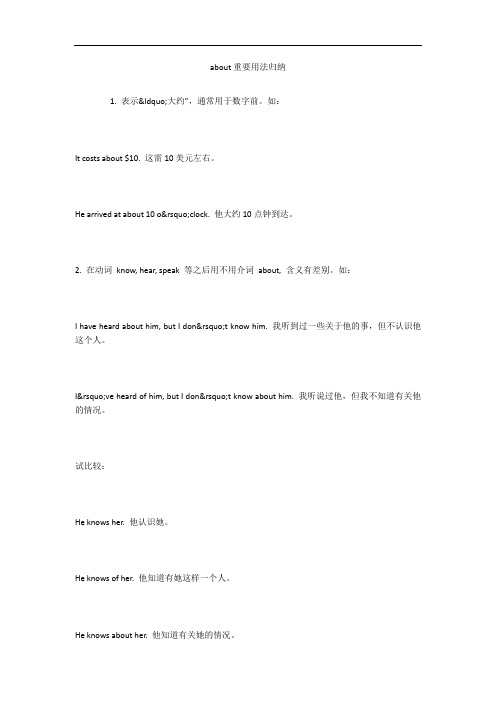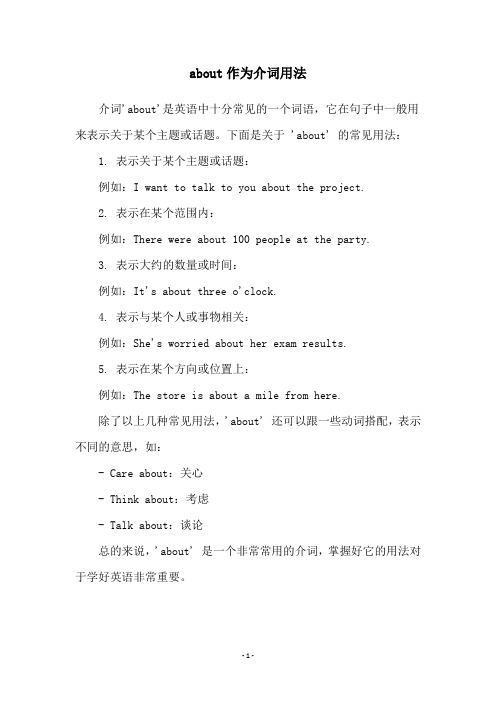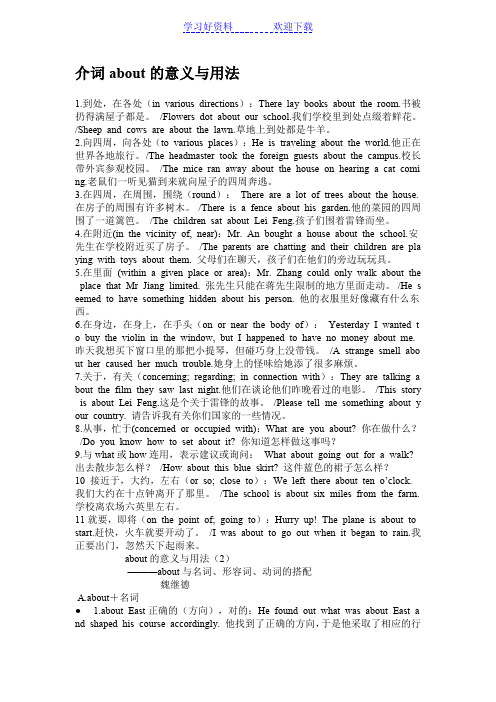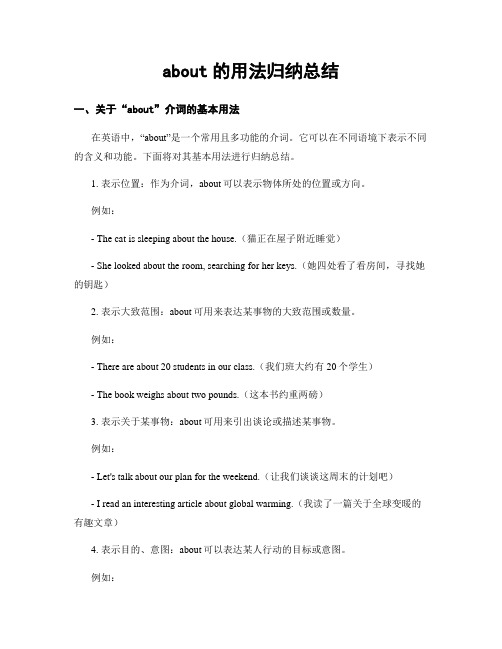介词about的用法
about重要用法归纳

about重要用法归纳1. 表示“大约”,通常用于数字前。
如:It costs about $10. 这需10美元左右。
He arrived at about 10 o’clock. 他大约10点钟到达。
2. 在动词know, hear, speak 等之后用不用介词about, 含义有差别。
如:I have heard about him, but I don’t know him. 我听到过一些关于他的事,但不认识他这个人。
I’ve heard of him, but I don’t know about him. 我听说过他,但我不知道有关他的情况。
试比较:He knows her. 他认识她。
He knows of her. 他知道有她这样一个人。
He knows about her. 他知道有关她的情况。
3. be about to (do),意为“即将”、“马上”。
注意该短语不与具体的时间状语(如:soon, tomorrow, immediately 等)连用。
如:We are about to leave for Beijing. 我们正要动身去北京。
不说:He is about to leave here tomorrow.注意该短语可与并列连词when(这时)连用。
如:I was (just) about to go to bed when the telephone rang. 我正要上床睡觉,这时电话铃突然响了起来。
在美国英语中,be about to do sth 的否定式,可表示“不愿意做某事”。
如:I am not about to admit defeat. 我还不想认输。
4. about和on均可表示“关于”,但about主要指泛泛地或非正式地谈论某事,其谈论的内容也较为普通;而on则指比较有系统地或理论性较强地论述某事,其论述的内容较正式或较严肃。
about与for的用法区别

about与for的用法区别一、about与for的用法区别在英语中,动词后常会跟着介词,其中"about"和"for"是两个常见的介词。
它们在使用上有一定的区别,下面将分析这两个介词的用法差异。
1. 表示目的的介词:"about"表示关于某事或某物的信息,而"for"表示为了某个目标或目的。
比如:A) "I read a book about dogs."(我读了一本关于狗的书。
)"about dogs"指的是书籍内容所涉及到的主题是狗。
B) "I bought a gift for my friend."(我给我的朋友买了一份礼物。
)"for my friend"意味着这份礼物是为我朋友准备的。
2. 表示围绕或涉及范围:"about"用于描述围绕某个话题或范围展开,而"for"通常指特定对象或一个特殊目标。
例如:A) "Let's talk about your vacation plans."(我们来谈谈你的度假计划。
)这里使用了“talk about”表示讨论一个具体话题, 即度假计划。
B) "This book is for children."(这本书是给孩子们准备的。
)这句话中,"for children"指的是这本书特别为儿童而设计。
3. 表示关于喜好或态度:"about"用于表达某人对事物的感受或看法,而"for"则表示对某事物有利或赞同。
例如:A) "She is very enthusiastic about sports."(她对体育非常热衷。
)这里使用了“enthusiastic about”表达对体育的兴趣和热情。
about作为介词用法

about作为介词用法
介词'about'是英语中十分常见的一个词语,它在句子中一般用来表示关于某个主题或话题。
下面是关于 'about' 的常见用法:
1. 表示关于某个主题或话题:
例如:I want to talk to you about the project.
2. 表示在某个范围内:
例如:There were about 100 people at the party.
3. 表示大约的数量或时间:
例如:It's about three o'clock.
4. 表示与某个人或事物相关:
例如:She's worried about her exam results.
5. 表示在某个方向或位置上:
例如:The store is about a mile from here.
除了以上几种常见用法,'about' 还可以跟一些动词搭配,表示不同的意思,如:
- Care about:关心
- Think about:考虑
- Talk about:谈论
总的来说,'about' 是一个非常常用的介词,掌握好它的用法对于学好英语非常重要。
- 1 -。
常用介词用法总结

常用介词用法总结以下是常用介词的用法总结:1. 关于(about):- 表示关于一些主题或话题,例如:We had a discussion about politics.(我们进行了一次关于政治的讨论。
)- 用于表示接近一些时间或数量,例如:It's about 5 o'clock.(大约是五点。
)2. 在…之上(above):- 表示在一些位置或高度之上,例如:The bird is flying above the trees.(鸟在树上方飞翔。
)- 表示比一些水平或程度更高,例如:Her English level is above average.(她的英语水平高于平均水平。
)3. 在…之下(below):- 表示在一些位置或高度之下,例如:The book is below the table.(书在桌子下面。
)- 表示比一些水平或程度更低,例如:The temperature is below freezing.(温度低于冰点。
)4. 在…中间(between):- 用于指示两个或多个事物之间的位置或关系,例如:He sat between Sarah and Tom.(他坐在莎拉和汤姆之间。
)- 用于表示时间或选择之间的区间,例如:The meeting is scheduled between 2pm and 4pm.(会议安排在下午两点到四点之间。
)5. 在…之内(within):- 表示在物或时间之内,例如:The keys are within the drawer.(钥匙在抽屉里面。
)6. 在…之外(outside):- 表示在一些范围或限制之外,例如:She prefers to eat outside the house.(她更愿意在房外吃饭。
)- 表示比一些地点或范围更远,例如:The gas station is just outside the city.(加油站就在城市外面。
介词about的意义与用法

介词about的意义与用法1.到处,在各处(in various directions):There lay books about the room.书被扔得满屋子都是。
/Flowers dot about our school.我们学校里到处点缀着鲜花。
/Sheep and cows are about the lawn.草地上到处都是牛羊。
2.向四周,向各处(to various places):He is traveling about the world.他正在世界各地旅行。
/The headmaster took the foreign guests about the campus.校长带外宾参观校园。
/The mice ran away about the house on hearing a cat comi ng.老鼠们一听见猫到来就向屋子的四周奔逃。
3.在四周,在周围,围绕(round):There are a lot of trees about the house.在房子的周围有许多树木。
/There is a fence about his garden.他的菜园的四周围了一道篱笆。
/The children sat about Lei Feng.孩子们围着雷锋而坐。
4.在附近(in the vicinity of, near):Mr. An bought a house about the school.安先生在学校附近买了房子。
/The parents are chatting and their children are pla ying with toys about them. 父母们在聊天,孩子们在他们的旁边玩玩具。
5.在里面(within a given place or area):Mr. Zhang could only walk about the place that Mr Jiang limited. 张先生只能在蒋先生限制的地方里面走动。
about的用法归纳总结

about的用法归纳总结一、关于“about”介词的基本用法在英语中,“about”是一个常用且多功能的介词。
它可以在不同语境下表示不同的含义和功能。
下面将对其基本用法进行归纳总结。
1. 表示位置:作为介词,about可以表示物体所处的位置或方向。
例如:- The cat is sleeping about the house.(猫正在屋子附近睡觉)- She looked about the room, searching for her keys.(她四处看了看房间,寻找她的钥匙)2. 表示大致范围:about可用来表达某事物的大致范围或数量。
例如:- There are about 20 students in our class.(我们班大约有20个学生)- The book weighs about two pounds.(这本书约重两磅)3. 表示关于某事物:about可用来引出谈论或描述某事物。
例如:- Let's talk about our plan for the weekend.(让我们谈谈这周末的计划吧)- I read an interesting article about global warming.(我读了一篇关于全球变暖的有趣文章)4. 表示目的、意图:about可以表达某人行动的目标或意图。
例如:- He is thinking about starting his own business.(他正在考虑创办自己的公司)- What are you so worried about?(你为什么如此担心呢?)5. 谈论时间:about可用来表示大致的时间范围。
例如:- They will arrive at about 6 o'clock.(他们将在六点左右到达)- I'll finish the project in about two weeks.(我会在大约两周内完成这个项目)二、“about”的短语用法除了作为介词,"about"还可以构成一些常见的短语,并赋予特定的含义。
中考英语about重要用法归纳
about 重要用法归纳1.表示“大体”,平时用于数字前。
如:It costs about $10.这需 10 美元左右。
He arrived at about 10 o他’大clock约10.点钟到达。
2.在动词 know,hear, speak等以后用不用介词 about, 含义有差异。
如: I have heard about him, but I don know him’t.我听到过一些关于他的事,但不认识他这个人。
I ’ ve heard of him, but I don’ t know我听about说过him他,.但我不知道有关他的状况。
试比较:He knows her.他认识她。
He knows of her.他知道有她这样一个人。
He knows about her.他知道有关她的状况。
3.be about to (do),意为“立刻”、“立刻”。
注意该短语不与详尽的时间状语(如: soon, tomorrow,immediately 等)连用。
如:We are about to leave for Beijing.我们正要出发去北京。
不说: He is about to leave here tomorrow.注意该短语可与并列连词when(这时 )连用。
如:I was (just) about to go to bed when the telephone rang.我正要上床睡觉,这时电话铃忽然响了起来。
在美国英语中, be about to do sth 的否定式,可表示“不肯意做某事”。
如:I am not about to admit defeat. 我还不想认输。
4.about 和 on 均可表示“关于”,但 about 主要指平时地或非正式地讨论某事,其讨论的内容也较为一般;而 on 则指比较有系统地或理论性较强地论述某事,其论述的内容较正式或较严肃。
比较:He wrote on mathematics.他撰写数学著作。
你不知道的介词用法
Wuchang Institute of Technology
1
above
Wuchang Institute of Technology
Civil Engineering
ห้องสมุดไป่ตู้After
against
…他的一切以团队为重的倾向。 1.[表示位置、空间]在…后面,在…背后,在…之后: I saw the man dragging a bundle of firewood after him. 我看见那男人身后拖着一捆柴。 2.[表示时间]在…以后;在…之后,于…后,迟于: We will discuss that matter after lunch. 午饭后我们要讨论那件事。 3.以…为追赶(或追求、搜寻、纠缠)的目标;寻找,跟踪,追随;跟在… 后面: I called after him three or four times. 我在他后面叫了三四次。 4.以…之故,因为,由于,鉴于,考虑到: You must be feeling tired, after that long walk. 你走了那么长路,一定觉得累了吧。 5.尽管…(但),不管,不顾: After all I had done, she was still ungrateful. 尽管我做了这一切,可她仍然不领情。 6.[表示顺序](跟)在…后面,继(或随)…之后: After you, sir. 先生,您先请。 7.[表示地位、位次或重要性]低于,次于,亚于: Milton is placed after Shakespeare. 弥尔顿的地位次于莎士比亚。 8.以…为模仿对象,仿,仿效: a novel after Dickens' style 一本模仿狄更斯文体的小说 9.照,依照,依从,按照: He can paint after a style. 他能照葫芦画瓢。 10.为了;为纪念…;取名于: A child named after Washington 一个以华盛顿名字命名的孩子 11.像: A child takes after its father. 孩子(长相、性格或举止)像父亲。 12.关于,有关: She asked after you. 她询问你的情况(或:她问候你)。 13.[用于连接并列的两项,表示接续](一个)接着(一个): day after day 日复一日 time after time 一次又一次,屡次 14.与…一致,与…相称;符合: a book quite after my own heart 一本合我心意的书 1.相反;反对;违反;违背;逆: against one's will 违心地,违背意愿地 to fight against evil 同邪恶做斗争 2.撞击;撞着,碰着,顶着,触及,与…相撞,同…冲突: to push against the door 用力推门 3.跟…接触: to throw the ball against the wall 用球击墙 4.逆行,逆…方向,对着;跟…反方向: to drive against the traffic (汽车)逆行
【初中英语】about重要用法归纳
【初中英语】about重要用法归纳1.表示“大约”,通常用于数字前。
如:itcostsabout$10.这需10美元左右。
hearrivedatabout10o’clock.他大约10点钟抵达。
2.在动词know,hear,speak等之后用不用介词about,含义有差别。
如:ihaveheardabouthim,butidon’tknowhim.我听见过一些关于他的事,但不重新认识他这个人。
i’veheardofhim,butidon’tknowabouthim.我听说过他,但我不知道有关他的情况。
先行比较:heknowsher.他认识她。
heknowsofher.他晓得存有她这样一个人。
heknowsabouther.他知道有关她的情况。
3.beaboutto(do),意为“即将”、“马上”。
特别注意该短语不与具体内容的时间状语(例如:soon,tomorrow,immediately等)属格。
例如:weareabouttoleaveforbeijing.我们正要动身去北京。
不说道:heisabouttoleaveheretomorrow.注意该短语可与并列连词when(这时)连用。
如:iwas(just)abouttogotobedwhenthetelephonerang.我急忙上床睡觉,这时电话铃忽然作响了出来。
在美国中,beabouttodosth的否定式,可表示“不愿意做某事”。
如:iamnotabouttoadmitdefeat.我还不敢认输。
4.about和on均可表示“关于”,但about主要指泛泛地或非正式地谈论某事,其谈论的内容也较为普通;而on则指比较有系统地或理论性较强地论述某事,其论述的内容较正式或较严肃。
比较:hewroteonmathematics.他编写著作。
hewroteabouttheschool.他报道有关这所学校的情况。
itisabookonbirds.那就是一本述及鸟类的书。
英语介词的用法
about英音:[ə'baut]美音:[ə'baut]介词prep.1.关于,对于My mother often spoke to me about you.家母常和我谈起你。
2.在...的附近;在...的周围She sat up and looked about her.她坐了起来,环顾四周。
3.在...的身边I had no money about me.我身边没有带钱。
4.大约在...时候It happened about 5 o'clock in the morning.这事发生在早晨约莫五点钟的时候。
5.从事于What the hell are you about?你到底在做什么?6.在...身上,在...的性格中What I like about him is his sense of humor.我喜欢的是他的幽默感。
副词ad.1.在四周;到处She likes to walk about.她喜爱四处走走。
2.在附近,在近处There were few people about.附近几乎无人。
3.大约;几乎John is about the same age as Tom.约翰和汤姆的年龄相仿。
4.向相反方向The ship turned about midway.船在中途掉转了航向。
in英音:[in]美音:[ɪn]in介词prep.1.在...里,在...上The two brothers study in the same class.两兄弟在同一个班里上课。
The telephone is in the little study on the ground floor.电话在一楼的小书房内。
2.在...之内;在...方面He is lacking in courage.他缺乏勇气。
3.从事于;参加着She is in business.她做生意。
4.穿着,戴着He is dressed in black.他穿黑衣服。
- 1、下载文档前请自行甄别文档内容的完整性,平台不提供额外的编辑、内容补充、找答案等附加服务。
- 2、"仅部分预览"的文档,不可在线预览部分如存在完整性等问题,可反馈申请退款(可完整预览的文档不适用该条件!)。
- 3、如文档侵犯您的权益,请联系客服反馈,我们会尽快为您处理(人工客服工作时间:9:00-18:30)。
介词about的用法
1.表示“关于”
This movie is about Lei Feng 这部电影是关于雷锋的。
Something about your country 一些关于你们国家的事.
2.表示“大约”
At about 6:00 大约在六点钟
About 100 meters 大约100米
3.与how/what连用,表示征求别人意见
How/what about + n/doing ?去...怎么样?/来个....怎么样?
How/what about + sb ?某人呢?
What about going for a walk? 去散步怎么样?
How about a cup of coffee? 来呗咖啡怎么样?
I like action movie.What about you? 我喜欢动作片。
你呢?
4.be about to do sth 正要做某事,就要做某事
The train is about to leave. 火车就要开了。
When he came to my home,I was about to go out. 他来我家时,我正准备出去。
5.带有about的动词短语
talk about sth 谈论某事
think about sth 考虑,想到
dream about sth 梦想某物/ 梦到某物
complain about sth 抱怨某物
worry about sb/sth 担心某人/某物
tell sb about sth 告诉某人某事
argue about sth 为某事吵架
hear about 听说
6.带有about的形容词短语
be angry about sth 因为某事生气
be careful about sth/sb 小心某物/某人
be worried about sb/sth 担心某人/某物
be curious about sth 对....很好奇
be excited about sth 对....感到激动
be happy/glad about sth 对...感到高兴
be sad about sth 对...感到难过
be sure/certain about sth 确信.../对...很确定/对...有把握
be serious about sth对...是认真的
be nervous about sth对...很紧张,不安
be upset about sth对...很不安
给大家推荐一个英语微信群-Empty Your Cup
英语微信群是目前学习英语最有效的方法,群里都是说英语,没有半个中文,而且规则非常严格,是一个超级不错的英语学习环境,群里有好多英语超好的超牛逼的人,还有鬼佬和外国美眉。
其实坦白说,如果自己一个人学习英语太孤独,太寂寞,没有办法坚持,好几次都会半途而废。
只要你加入到那个群里以后,自己就会每天都能在群里坚持学,坚持不停地说和练,由于是付费群,群里的成员学习氛围非常强,每天的训练度都非常猛,本来很懒惰的你一下子就被感染了,不由自主地被带动起来参与操练,不好意思偷懒,别人的刻苦学习精神会不知不觉影响你,Empty Your Cup英语微信群(进群加喂新 601332975)可以彻底治好你的拖延症,里面学员都非常友好,总是给你不断的帮助和鼓励,让你在学英语的路上重新燃起了斗志,因为每天都在运用,你的英语口语就能得到了迅猛的提升,现在可以随便给一个话题,都能用英文滔滔不绝的发表5分钟以上对这个话题的看法和观点,想提高英语口语的 可以加入进来,It really works very well.。
